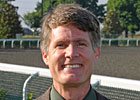(Originally published in the September 14, 2013 issue of The
Blood-Horse magazine. Feel free to share your own thoughts and
opinions at
the bottom of the column.)
By Eric Mitchell - @BH_EMitchell on Twitter
 The group’s goal is simple, according to Keeneland president Bill Thomason, a founding member: to provide excellent experiences at the racetrack for owners and fans.
The group’s goal is simple, according to Keeneland president Bill Thomason, a founding member: to provide excellent experiences at the racetrack for owners and fans.
“We want growth of our fans, growth of our owners, and more people attaching themselves to our horses,” Thomason said. “We are not talking about maintaining our business; we are talking about growing our business.”
Improving customer service at racetracks is certainly not a new concept, but it got a kick-start earlier in the year from John Ferguson, Sheikh Mohammed’s bloodstock adviser, who stressed with industry leaders that the sport cannot grow without a genuine commitment to improving customers’ experiences.
“It really isn’t that hard to see—all you have to do is go racing,” said Ferguson. “I’m glad to see Bill and the group taking a hold of it.”
The initiative began with a larger group that included representatives from major farms, sales companies, the Thoroughbred Owners and Breeders Association, as well as major racetracks. A poll and one-on-one interviews with many of the country’s most prominent owners were conducted about three months ago, and the results were not surprising.
“We know we have deficiencies; all of us running racetracks know of things we need to improve for our owners’ experience at the racetrack,” Thomason said. “But what we heard are common themes all across the country.”
The next step was to put the initiative in the hands of like-minded, committed racetrack executives and get them rowing in the same direction. They started by sending executives and customer service representatives with the New York Racing Association, Keeneland, Del Mar, and The Stronach Group to a Ritz Carlton training program. Thomason said the experience was “eye-opening.”
“No excuses” was one of the many lessons they all took away.
“There are a lot of reasons you can’t do things, but if it is important to the experience and important to our end objectives, then we have to quit making excuses and find the way to deliver what our customers expect,” Thomason said. “We developed good communication between the tracks and broke down some barriers about what we are doing and trying to do. It is important for the industry to realize the racetracks really do care; they are interested in doing those things that are important for the growth of the business.”
Presidents and other executives from NYRA, Del Mar, Keeneland, and The Stronach Group plan to meet at Keeneland in October to begin discussing ways to formalize their program in order to provide a more consistently good experience for both owners and fans across all their properties.
“We know there are things we cannot do cooperatively, but we know there are plenty of areas in which we can,” Thomason said. “It is critical to the overall health of the industry that racing is strong in New York, California, Florida, and Kentucky. We are interested in raising the level across the country.”
Similar cooperative initiatives have been implemented successfully by other professional sports. The NBA created a Team Marketing & Business Operations division that promoted best practices in ticket sales, sponsor development, suite sales, customer retention, digital sales, and marketing. One successful promotion to season-ticket holders even gave away reversible jerseys with the names and team logos for opposing teams on each side.
The NFL is going into its sixth season with a ticket exchange program that allows fans to sell their tickets to one another. The NFL Ticket Exchange program has been enhanced this year by allowing fans to see what tickets the teams have available alongside the ones being resold.
Racetracks face a myriad of customer service challenges with older facilities and capital expenditure constraints, and the meeting in October is unlikely to unleash a sweeping customer service plan. And that’s OK, but let’s hope it leads to some improvement. Any gains will be appreciated and hopefully lead to a stronger business model.
“I understand the complications and the barriers to being able to take on, sometimes, huge problems,” Thomason said. “There is one mentality that says, ‘Well, if I can’t do this whole big thing, then I can’t do anything.’ I just don’t think like that. There are things you can do within existing constraints to help you move forward toward your objective.”
No excuses.




